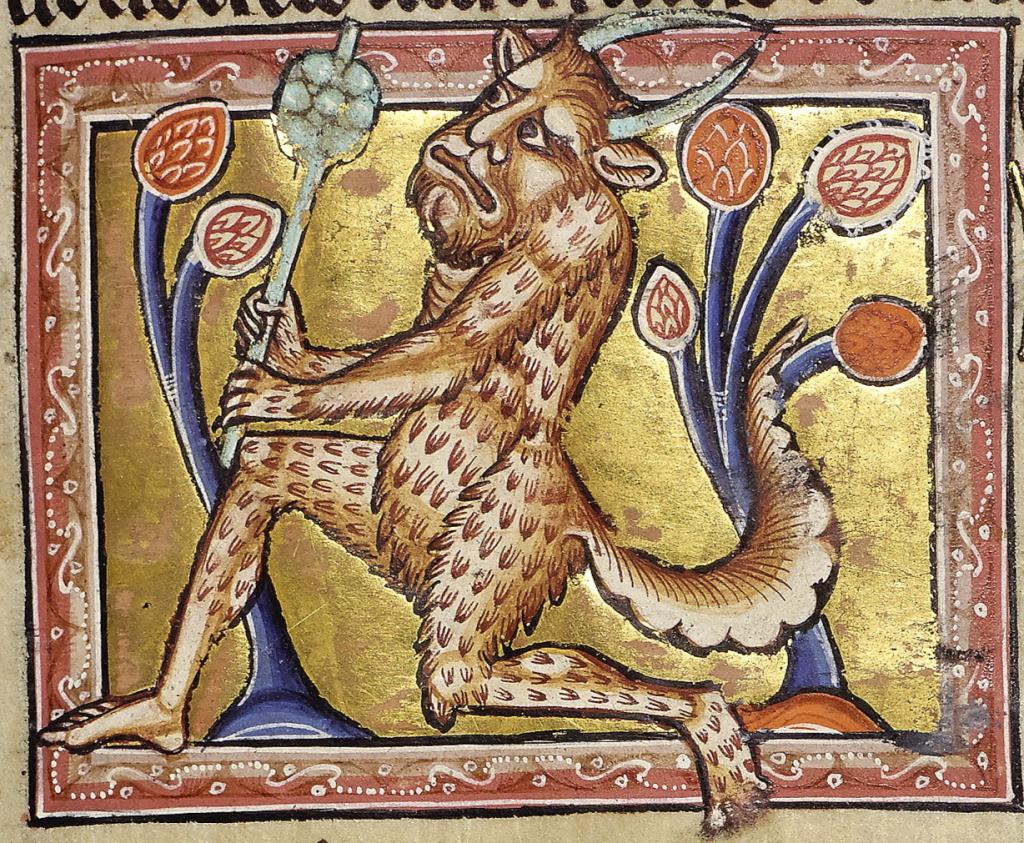Today’s post concerns two topics of long-standing interest to me, and how – very oddly – they intersect. One is horror and supernatural fiction; the other is Bible translation and its dilemmas. How on earth does one illuminate the other? Briefly, the familiar translations of the Bible gave surprisingly rich potential for horror authors in search of frightening supernatural texts and imagery, quite apart from all those familiar demons. And yes, I do intend this as appropriate reading for the upcoming Halloween season.
I have for much of my life been a huge fan of the classic British authors in this genre, many of whom flourished in the early years of the last century – M. R. James above all, but also E. F. Benson, Walter de la Mare, Algernon Blackwood, and the rest. All came from strongly religious and Bible-centered backgrounds, some were from clergy families, and James was a world class scholar of Bible and apocrypha, whose opinions still carry academic weight. If you want to see a true scholar at work, just read his The Wanderings and Homes of Manuscripts (1919) and be dazzled. Naturally, these authors threw a great many Biblical references into their stories, and you are missing a lot if you don’t grasp them.
They particularly liked certain passages in which the Bible provided scriptural warrant for the various horrors they were describing – ghosts, demons, vampires, and the rest. One very popular and much quoted text came from the Book of Isaiah, or to be more precise, two very closely linked passages, respectively in chapters 13 and 34. In James’s story “Canon Alberic’s Scrap-Book” (1894), the English hero who has met a hideous demon remembers that “Isaiah was a very sensible man; doesn’t he say something about night monsters living in the ruins of Babylon? These things are rather beyond us at present.” As we will see, Isaiah did say exactly that.
That passage from Isaiah 34 is central to James’s “An Episode in Cathedral History” (1914), a classic and much reprinted vampire story. In one scene, a character records a ghostly visitation. No, he did not sleep last night: It was “rather too much of Isaiah xxxiv. [34.] 14 for me.”
“xxxiv. 14,” says Mr. Henslow, “what’s that?”
“You call yourself a Bible reader!” says Mr. Lyall. (Mr. Henslow, you must know, he was one of what used to be termed Simeon’s lot—pretty much what we should call the Evangelical party.) “You go and look it up.”
I wanted to know what he was getting at myself, and so off I ran home and got out my own Bible, and there it was: “the satyr shall cry to his fellow.” Well, I thought, is that what we’ve been listening to these past nights? and I tell you it made me look over my shoulder a time or two.”
The evil presence is a powerful vampire, and at the site of a sinister tomb, they erect the inscription from that same verse as it is found in the Latin Vulgate, Ibi cubavit lamia – “There laid the Lamia (or night demon, or screech owl),” with lamia referring to a truly frightening Classical Greek night demon or hag. James and the other authors did not themselves believe in these various demons, satyrs, lamias, or night monsters, but their fictional characters found explicit evidence for them in the Bible. (See the thoughtful discussion of James’s lamia here).
By this point, you might reasonably be asking where on earth they are finding all this? Are all these monsters really found in the Bible? The answer is both yes and no. In the translations that were standard for most Christians for many centuries, they actually were. Today, the relevant verses have been pretty fully exorcised.
I will look at two main things, namely the satyrs, and the lamia. By way of background, the prophet Isaiah prophesies the fall and destruction of Babylon, and according to the New International Version, declares that
She will become a haunt for jackals,
a home for owls.
Desert creatures will meet with hyenas,
and wild goats will bleat to each other;
there the night creatures will also lie down
and find for themselves places of rest. (Isaiah 34.13-14)
A very similar passage in Isaiah 13 envisions the city haunted by jackals, hyenas, wild goats, and desert creatures (13.21-22). The picture is evocative, but clearly non-supernatural, and all the creatures listed are zoologically plausible. We could be watching a David Attenborough documentary. This is also a reasonable reflection of the Hebrew original, if not the only correct or obvious rendering.
So where did the demons and monsters come from? Well, a couple of key Hebrew words readily lend themselves to multiple interpretation. The creatures who will cry to each other are called sa’iyr, which means hairy or shaggy, as in the story of Jacob and Esau: “But my brother Esau is a hairy man.” A “hairy” could certainly mean an animal like a wild goat, and that meaning makes great sense here, but there were also various mythical or marginal creatures like fauns or satyrs.
Also loaded is the “night creatures.” The frequent Biblical word for night is layil, but this is the unique occurrence in that text for the word used here, liyliyth. That might mean night creatures generally, or the screech owl. But over time, that verse became the Biblical source for the female specter or demon Lilith, who enjoyed a very lengthy supernatural career. Already by the time of the Dead Sea Scrolls, she was listed in a roster of “destroying angels, spirits of the bastards, demons, Lilith, howlers.” In early Rabbinic times, she was remembered as Adam’s first wife.
Robert Alter translates 34.14 as “And wildcats shall meet hyenas, / and the satyr shall call to its mate. There Lilith shall rest / and find repose for herself.” Some renderings use the plural, Liliths.
Just from the Hebrew, then, you have the potential, at least, for supernatural creatures who were “hairies” or “night specters.” Both words would have a long and very creative aftermath. As translators tried to render those terms into other languages, they faced two main problems. One is that the meanings of particular words were genuinely open to debate, particularly when referring to living creatures: you draw on the natural history that you see around you, and Egypt’s (say) was different from Mesopotamia’s. Also, when the text was rendered into Greek in the third or second century BC, those Septuagint translators had a strong and, we might say, notorious predilection for finding demons and supernatural beasts wherever they could, and even in places where it took a real stretch to find things of this sort. They were very enthusiastic about demons.
In its translation of Isaiah 34, the Septuagint Greek warns that the city will become a habitation of sirens (seirenes) and ostriches (! strouthon), where demons (daimonia) shall meet with donkey-centaurs (onokentaurois), and will call to one another. Sirens, demons, and donkey-centaurs also feature in chapter 13. Some of these Septuagint’s word choices are downright weird. (I am using the excellent NETS translation by Moisés Silva).
The Septuagint then became the basis for the Latin Vulgate, which was the standard Bible for Latin Christianity for over a millennium, and for the Roman Catholic church until quite modern times. Here are the Vulgate words of Is. 34.13-14:
et erit cubile draconum, et pascua struthionum. Et occurrent daemonia onocentauris, et pilosus clamabit alter ad alterum; ibi cubavit lamia, et invenit sibi requiem.
Once again, the language is totally “bestial” and supernatural, with dragons, demons, and lamias, instead of real-world hyenas and goats. Exactly what was meant to be calling out to its fellow stirred some controversy. The Latin pilosus indicated the “hairy” quality, opening the door to something like the satyrs of Classical mythology. The liyliyth, meanwhile, is now a lamia. One repellent feature of the lamia was that she ate children in the night. From early Rabbinic times, Lilith had much the same character, as a night hag who preyed on children. The one translated naturally into the other.
Protestant translators of the sixteenth and seventeenth centuries wanted to get back to the Hebrew, unmediated by the millennium of Latin and Greek readings. But at the same time, they had no realistic sense of the zoology or ecology of Mesopotamia, and what creatures actually roamed there. Who knew but that there might really be satyrs? Here is Martin Luther’s influential Bible of 1545:
und wird eine Behausung sein der Drachen und Weide für die Straußen. Da werden untereinander laufen Marder und Geier, und ein Feldteufel wird dem andern begegnen; der Kobold wird auch daselbst herbergen und seine Ruhe daselbst finden. (Is.34.13-14)
Do note the dragon, and the continuing demonic themes, with the Feldteufel crying out to its fellow. It’s lovely to find here a Kobold lying down to rest, rather than a lamia. This was a very German folklore creature, that we might translate as a goblin or pixie. It’s something that would feel distinctly out of place in ancient Mesopotamia, except possibly on a package holiday from Stuttgart. In chapter 13, Luther describes Feldgeister, “field spirits.”
The King James translators of 1611 closely followed Luther. Hence, their rendering was still strikingly Classical and demonic, with “satyrs” well established. Here is the passage in chapter 13:
But wild beasts of the desert shall lie there; and their houses shall be full of doleful creatures; and owls shall dwell there, and satyrs shall dance there. And the wild beasts of the islands shall cry in their desolate houses, and dragons in their pleasant palaces. (Is 13.21-22)
And here are the words of chapter 34.14, the passage that proved too much for the nervous M. R. James character who had to face the ghosts of the night:
And thorns shall come up in her palaces, nettles and brambles in the fortresses thereof: and it shall be an habitation of dragons, and a court for owls. The wild beasts of the desert shall also meet with the wild beasts of the island, and the satyr shall cry to his fellow; the screech owl also shall rest there, and find for herself a place of rest. (Is.34 13-14).
That is what the late Victorian horror writers were referring to. And anyone who dug a little deeper in the Latin would soon get back to the fearsome lamia.
What this example shows is just how hard it was for even the most erudite and dedicated translators to recapture the social and biological realities of the Ancient Near East. But it also suggests just how weird and folkloric were some of the readings that were preserved in quite mainstream translations like Luther’s, and the King James after him. It really could be “rather too much of Isaiah xxxiv. 14 for me.” In 1895, George MacDonald drew on the vampiric Lilith/Lamia legend for his truly bizarre novel Lilith. That was exactly the same time as “Canon Alberic’s Scrap-Book.”
So yes, the King James really did provide excellent ammunition for Gothic and horror writers, and they did not have to look too far to find evidence for their supernatural creations.
If you have not read your way through the whole of M. R. James, this Halloween would be just a wonderful time to start. Leave the lights on.
Some Very Selective References
Peter Joshua Atkins, “Mythology or Zoology: A Study on the Impact of Translation History in Isaiah 13:21,” Biblical Interpretation 24(1)(2016): 48-59.
Patrick J. Murphy, Medieval Studies and the Ghost Stories of M. R. James (Penn State Press, 2017).
Irven M. Resnick and Kenneth F. Kitchell, “The Sweepings of Lamia: Transformations of the Myths of Lilith and Lamia,” in Alexandra Cuffel and Brian Britt, eds., Religion, Gender, and Culture in the Pre-Modern World (Palgrave Macmillan 2007), 77-104.
John H. Walton and J. Harvey Walton, Demons and Spirits in Biblical Theology: Reading the Biblical Text in Its Cultural and Literary Context (Wipf and Stock, 2019).
As on many obscure topics, there is a wonderful discussion of early views of lamias and related beasts in Henry Charles Lea, Materials Toward A History Of Witchcraft, edited by Arthur C. Howland (University of Pennsylvania Press, 1939), vol. i, 109-113. Lamias actually occur throughout Lea’s encyclopedic work, as the word entered the generic vocabulary used to describe witches and evil beings through the Early Modern period and beyond. M. R. James knew that literature inside out.













